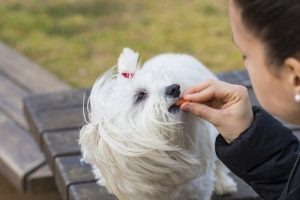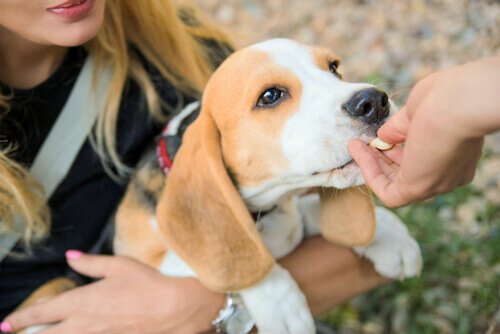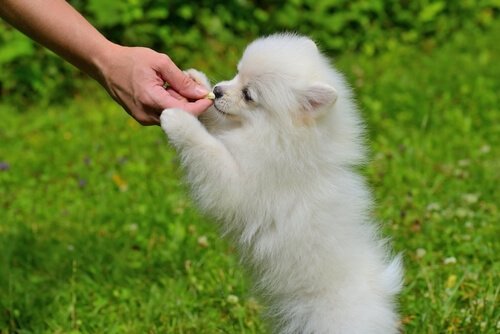Rewards for Dogs: Tips and Considerations

When to use rewards for dogs

- He does something you like before you order him to. For example, perhaps you usually ask him to get off the couch so that you can sit down? But he gets off when you approach, even though you had not given him the order to do so.
- When he is tempted to behave badly but chooses to behave well. For example, when he is at the table and merely looks at the food instead of trying to eat it.
- We are teaching him something new and, although he still does not completely understand it, he is starting to. If you want to teach him to lie down, before he completely lies down you can reward him when he starts to crouch.
- When he comes to you in the park, whether you have called him or not. You should always reward him when he stops what he is doing and comes. Even if you have not called him, you can reward him because he is checking up on you.
- Just because! Because you have a good dog that usually behaves well and you want to thank him for being so affectionate, loyal and patient with you.
When to reward
What not to use as rewards for dogs
The prizes must be small, but fit for each dog. You cannot cut a sausage into pieces of the same size to reward both a Maltese Bichon and a Belgian Shepherd. Likewise, a puppy’s teeth are not as strong as those of an adult or an elderly dog.
What to use as rewards for dogs

- hotdogs for human consumption
- pieces of cured cheese
- cooked ham or bologna
- industrial dog biscuits split into small pieces
- Paté or wet dog food
- Better quality dog food or of a different flavor to what he normally eats
Other prizes
When to use rewards for dogs

- He does something you like before you order him to. For example, perhaps you usually ask him to get off the couch so that you can sit down? But he gets off when you approach, even though you had not given him the order to do so.
- When he is tempted to behave badly but chooses to behave well. For example, when he is at the table and merely looks at the food instead of trying to eat it.
- We are teaching him something new and, although he still does not completely understand it, he is starting to. If you want to teach him to lie down, before he completely lies down you can reward him when he starts to crouch.
- When he comes to you in the park, whether you have called him or not. You should always reward him when he stops what he is doing and comes. Even if you have not called him, you can reward him because he is checking up on you.
- Just because! Because you have a good dog that usually behaves well and you want to thank him for being so affectionate, loyal and patient with you.
When to reward
What not to use as rewards for dogs
The prizes must be small, but fit for each dog. You cannot cut a sausage into pieces of the same size to reward both a Maltese Bichon and a Belgian Shepherd. Likewise, a puppy’s teeth are not as strong as those of an adult or an elderly dog.
What to use as rewards for dogs

- hotdogs for human consumption
- pieces of cured cheese
- cooked ham or bologna
- industrial dog biscuits split into small pieces
- Paté or wet dog food
- Better quality dog food or of a different flavor to what he normally eats
Other prizes
All cited sources were thoroughly reviewed by our team to ensure their quality, reliability, currency, and validity. The bibliography of this article was considered reliable and of academic or scientific accuracy.
- Galvão, J. A., Yamatogi, R. S., Souza Junior, L. C. T., Joaquim, J. F., Rodrigues, M. V., Baldini, E. D., & Nogueira Pinto, J. P. D. A. (2015). Quality and safety of pet treats: Assessment of the microbial safety and quality of pet treats. Journal of Food Processing and Preservation, 39(6), 1201-1205.
- Chan, S. K., & Leung, D. Y. (2018). Dog and cat allergies: current state of diagnostic approaches and challenges. Allergy, Asthma & Immunology Research, 10(2), 97-105.
- Dopierała, Marta & Andraszek, Katarzyna. (2019). THE MOST COMMON ALLERGIC DISEASES IN DOGS. Folia Pomeranae Universitatis Technologiae Stetinensis Agricultura, Alimentaria, Piscaria et Zootechnica. 348(49)1. 47-56. 10.21005/AAPZ2019.49.1.05.
- Carrión, Pablo & Thompson, Larry. (2013). Pet Food. Food Safety Management: A Practical Guide for the Food Industry. 379-396. 10.1016/B978-0-12-381504-0.00015-9.
This text is provided for informational purposes only and does not replace consultation with a professional. If in doubt, consult your specialist.








